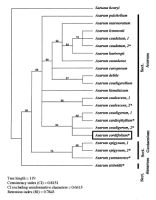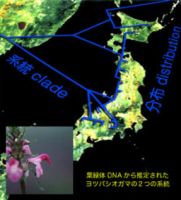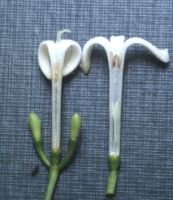|
|
 Systematic Botany Laboratory
Systematic Botany Laboratory
|
Our unifying goal is to understand the diversity and evolution of higher plants. Toward this end, we are investigating particular plants found in Japan and adjacent areas from various aspects. We are also involved in the management of Makino Herbarium (MAK).
|
|
Prof |
Noriaki Murakami |
e-mail |
|
|
Asc Prof |
Takashi Sugawara |
e-mail |
|
|
Asc Prof |
Yoko Kakugawa |
e-mail |
|
|
Ast Prof |
Hidetoshi Kato |
e-mail |
|
|
|
Taxonomy and Phylogeny of Higher Plants
|
|

Phylogenetic relationship of Asarum cordifolium and its related species
To understand the diversity and evolutionary history as well as the evolutionary process of higher plants, we are investigating several plant groups such as Aristolochiaceae, Rutaceae, Scrophulariaceae, etc.
|
|
|
Phytogeography
|
|

Chloroplast DNA phylogeny and phytogeography of Pedicularis chamissonis var. japonica
Each plant usually has a distinct area of distribution with varying geographical distribution. To infer the evolutionary history or past migration of plants we are investigating the geographical genetic variations of chloroplast or nuclear DNA on some alpine or temperate plants.
|
|
|
Floral and Reproductive Biology in Flowering Plants
|
|

Heterostyly found in Psychotria homalosperma
To understand the evolution of flowering plants it is important to know not only how plants vary in floral structure but also how their reproductive systems serve to maintain their natures. We are investigating insect-pollinated plants with peculiar floral structures, and plants with sexual polymorphism or heterostylous nature in flowers.
|
|
|
Recent Publications
|
|
- Fujii, N. and K. Senni (2006) Phylogeography of Japanese alpine plants: biogeographic importance of alpine region of central Honshu in Japan. Taxon (in press).
- Kato, H., K. Hata, H. Yamamoto and T. Yoshioka (2006) Effectiveness of weed risk assessment system for plant introductions to the Bonin Islands. In : Proceedings of Assessment and Control of Biological Invasion Risks (in press).
- Kobashi, S., N. Fujii, A. Nojima, N. Hori (2006) Distribution of chloroplast DNA haplotypes in the contact zone on Fagus crenata in the southwest of Kanto District, Japan. J. Plant Res. (in press).
- Murata, J., H. Murata, T. Sugawara and S.G. Wu (2006) New or noteworthy chromosome records in Arisaema (Araceae) (3). J. Jpn. Bot. (in press).
- Shinohara, W., Hsu, T. W., Moore, S. J. and Murakami, N. (2006) Genetic analysis of the newly found diploid cytotoype of Deparia petersenii (Woodiaceae: Pteridophyta): Evidence for multiple origins of the tereploid. Int. J. Plant Sci. 167: 299-309.
- Tanaka, N. and T. Sugawara (2006) The use of edible Canna in Kachin State, Upper Myanmar. J. Jpn. Bot. (in press).
- Aoki, K., Kato, M. and Murakami, N. (2005) Mitochondrial DNA of phytophagous insects as a molecular tool for phylogeographic study of host plants. J. Plant Res. 56: 55-69.
- Okuyama, Y., Fujii, N., Wakabayashi, M., Kawakita, A., Ito, M., Watanabe, M., Murakami, N. and Kato, M. (2005) Nonuniform concerted evolution and chloroplast capture: Heterogenity of observed introgression pattern in three molecular data partition phylogenies of Asian Mitella (Saxifragceae). Mol. Biol. Evol. 22: 285-296.
- Pfosser, M., G. Jakubowsky, P. M. Schluter, T Fer, H Kato, T Stuessy and B.-Y. Sun (2005) Evolution of Dystaenia takesimana (Apiaceae), endemic to Ullung Island, Korea. Plant Systematics and Evolution 256: 159-170.
- Senni, K., N. Fujii, H. Takahashi, T. Sugawara, and M. Wakabayashi (2005) Intraspecific chloroplast DNA variation of the alpine plants in Japan. Acta Phytotaxonomica et Geobotanica. 56: 265-275.
- Seo, A., Nobushima, F. and Murakami, N. (2005) Genetic status of Angelica japonica var. boninensis (Umbelliferae) distributed in the Bonin and the Daito Islands. Acta Phytotax. Geobot. 56: 173-182.
- Sugawara, T., N. Fujii, K. Senni, and J. Murata (2005) Morphological and karyological characteristics and phylogenetic relationship of Asarum cordifolium C. E. C. Fisch. (Aristolochiaceae) occurring in Myanmar. Acta Phytotaxonomica et Geobotanica. 56: 247-255.
- Takayama, K., T. Ohi-Toma, H. Kudoh and H. Kato (2005) Origin and diversification of Hibiscus glaber, species endemic to the oceanic Bonin Islands, revealed by chloroplast DNA polymorphism. Molecular Ecology 14: 1059-1071.
- Yatabe, Y., Murakami, N. and Iwatsuki, K. (2005) Claytosumuda; a new subgenus of Osmunda (Osmundaceae). Acta Phytotax. Geobot. 56: 127-128.
- Aoki, K., Suzuki, T., Hsu T.W. and Murakami, N. (2004) Phylogeography of the component species of broad-leaved evergreen forests in Japan, based on chloroplast DNA variation. J. Plant Res. 117: 77-94.
- Aoki, K. , Hattori, T. and Murakami, N. (2004) Intraspecific sequence variation of chloroplast DNA among the component species of evergreen broad-leaved forests in Japan II. Acta Phytotax. Geobot. 55: 125-128.
- Dohzono, I., Suzuki, K. and Murata, J. (2004) Temporal changes in calyx-tube length of Clematis stans (Ranunculaceae): a strategy for pollination by two bumble bee species with different proboscis lengths. Amer. J. Bot. 91: 2051-5059.
- Kato, H., Yamane, S. and Phengklai, C. (2004) Ant-colonized domatia on fruits of Mucuna interrupta (Leguminosae). J. Plant Res. 117: 319-321.
- Miwa, H., Hsu, T. W., Cheng, X. , Suhara, J. and Murakami, N. (2004) Molecular systematic study of Asian Conocephalum japonicum (Hepaticae). Acta Phytotax. Geobot. 55: 9-18.
- Oginuma, K., Yokota, M. and Sugawara, T. (2004) Cytological study of two species of Myoporum (Myoporaceae) in Japan. Chromosome Science 7: 15-18.
- Okuyama, Y., Kato, M. and Murakami, N. (2004) Pollynation by fungus fnats in four species of the genus Mitella (Saxifragaceae). Bot. J. Linn. Soc. 144: 449-460.
- Oohara, T., Serizawa, S. and Wakabayashi, M. (2004) A new species of Prunus (Rosaceae) from the Tama Hills, West Tokyo, Japan. J. Jpn. Bot. 79: 343-349.
- Seo, A., Watanabe, M., Hotta, M. and Murakami, N. (2004) Geographical patterns of allozyme variation in Angelica japonica (Umbelliferae) and Farufugium japonicum (Compositae) on the Ryukyu Islands, Japan. Acta Phytotax. Geobot. 55: 29-44.
- Sugawara, T., Watanabe, K., Kato, H., and Yasuda, K. (2004) Dioecy in Wikstroemia pseudoretusa (Thymelaeaceae) endemic to the Bonin (Ogasawara) Islands. Acta Phytotax. Geobot. 55: 55-61.
- Fujii, N. (2003) Chloroplast DNA phylogeography of Pedicularis resupinata (Scrophulariaceae) in Japan. Acta Phytotax. Geobot. 54: 163-175.
- Ohi, T., Wakabayashi, M., Wu, S.G. and Murata, J. (2003) Phylogeography of Stachyurus praecox (Stachyuraceae) in the Japanese Archipelago based on chloroplast DNA haplotypes. J. Jpn. Bot. 78: 1-14.
- Sugawara, T. (2003) Morphological and cytological variation in Asarum fauriei (Aristolochiaceae) in central and northern Honshu, Japan. Acta Phytotax. Geobot. 54: 149-162.
- Soc. Him. Bot. Tokyo.
- Osaloo, S.k., Maassoumi, A.A. and Murakami, N. (2003) Molecular Systematics of the Genus Astragalus L. (Fabaceae): Phylogenetic analyses of nuclear ribosomal DNA internal transcribed spacers and chloroplast gene ndhF sequences. Plant Syst. Evol. 242: 1-32.
- Shinohara, W., Takamiya, M. and Murakami, N. (2003) Taxonomic study of Japanese Deparia petersenii (Woodsiaceae) based on cytological and molecular information. Acta Phytotax. Geobot. 54: 137-148.
- Miwa, H., Suhara, J., Kitagawa, N. and Murakami, N. (2003) Biosystematic study of Japanese Conocephalum japonicum (Hepaticae) based on rbcL sequence and allozyme data. Acta Phytotax. Geobot. 54: 37-48.
- Aoki, K., Suzuki, T. and Murakami, N. (2003) Intraspecific sequence variation of chloroplast DNA among the component species of evergreen broad-leaved forests in Japan. J. Plant Res. 116: 337-344.
- Yatabe, Y. and Murakami, N. (2003) Recognition of cryptic species in the Asplenium nidus complex using molecular data. Telopea 10: 487-495.
|
|
|